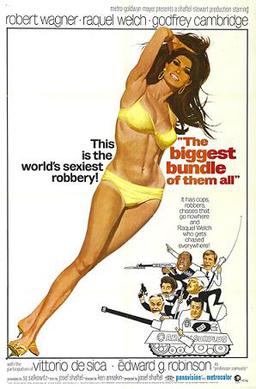 Harry Price (Robert Wagner) is a small-time tough guy with big plans. He and his gang of accomplices fly over to Italy and plot to kidnap Cesare Celli (Vittorio De Sica), a retired mafia don who is reputed to be worth millions. However, after snatching Celli from a wedding, Harry discovers that Celli is actually flat broke. Trying to be helpful, Celli suggests that Harry call up the local gangsters and demand that they pay a ransom for Celli’s release. When everyone refuses to pay, Celli comes up with another plan. Celli takes over Harry’s gang and, with the help of Celli’s old friend, Prof. Samuels (Edward G. Robinson), plots to steal $5,000,000 worth of platinum ingots from a train.
Harry Price (Robert Wagner) is a small-time tough guy with big plans. He and his gang of accomplices fly over to Italy and plot to kidnap Cesare Celli (Vittorio De Sica), a retired mafia don who is reputed to be worth millions. However, after snatching Celli from a wedding, Harry discovers that Celli is actually flat broke. Trying to be helpful, Celli suggests that Harry call up the local gangsters and demand that they pay a ransom for Celli’s release. When everyone refuses to pay, Celli comes up with another plan. Celli takes over Harry’s gang and, with the help of Celli’s old friend, Prof. Samuels (Edward G. Robinson), plots to steal $5,000,000 worth of platinum ingots from a train.
Complicating matters is that Harry and his gang are not exactly master criminals. Benny (Godfrey Cambridge) is a violinist who has moral objections to carrying a gun and who also refuses to cross a picket line, even in the course of a robbery. (“I’m a union man!”) Tozzi (Francesco Mule) is more interested in having a good dinner than pulling off the perfect heist. Davey (Davy Kaye) is short, which is apparently a problem for some reason. Finally, Harry’s girlfriend, Juliana (Raquel Welch), is more interested in dancing than in committing crimes. Still, Celli is determined to use them to pull off the heist of the century and, even more importantly, to help prove that this old criminal has still got what it takes.
The Biggest Bundle of Them All was an attempt at a wacky heist film. Unfortunately, at the time that the film was made, Robert Wagner and “wacky” didn’t belong anywhere near each other. Wagner stiffly delivers lines like, “I’ve had it, baby. Can you dig it?” and looks thoroughly out-of-place. Godfrey Cambridge and Edward G. Robinson have a few funny scenes but both Kaye and Mule are wasted in one-note role while De Sica looks like he’s trying to figure out how he went from Bicycle Thieves to this. Everyone in the movie just goes through the motions. Even while they’re robbing the train, the cast seems to be indifferent.
It almost doesn’t matter, though, because this is a Raquel Welch film. Welch doesn’t have much of a character to play but she looks amazing while doing it and that really is the appeal of any film that Welch made in the late 60s and early 70s. Welch spends a good deal of the film in a bikini and is undeniably sexy, particularly in the scene where Wagner sends her to seduce De Sica. She also gets to share a dance with Edward G. Robinson, which is such a goofy and fun scene that it’s almost worth the price of admission. (Regardless of what fun they may have been having on-screen, Robert Wagner later wrote in his autobiography that, off-screen, Robinson grew so annoyed with Welch’s chronic lateness on the set that he yelled at her until she was in tears.)
Even Raquel Welch in a bikini can only carry a film so far and The Biggest Bundle of Them All is ultimately too disjointed to work. Director Ken Annakin tries to recreate the same sort of frantic comedy that was at the heart of his previous film, Those Magnificent Men in Their Flying Machines, but the end result falls flatter than 5 million dollars worth of platinum ingots sliding out of an airplane.












